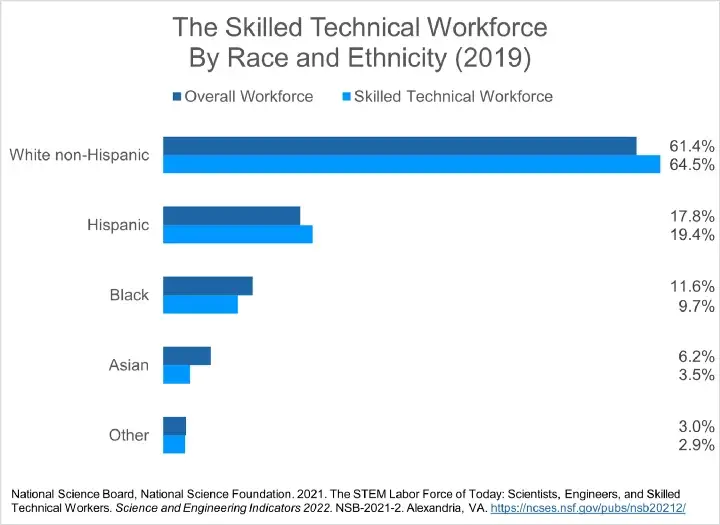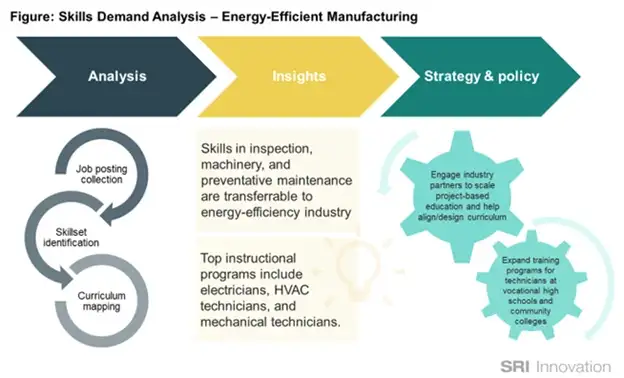Authors: Christiana McFarland, Christa Reid, Michael Lee and Gigi Jones in SRI International’s Center for Innovation Strategy and Policy

As technology transforms industries and the nature of work, expanding the STW is critical to building competitive, inclusive economies
As the labor market continues to struggle to find its footing, the practices of economic and workforce development are increasingly concerned with alleviating the labor shortage and promoting equitable growth.
When facing the “how,” one answer can be found with the skilled technical workforce.
The skilled technical workforce, or STW, is a subset of the science, technology, engineering and mathematics (STEM) workforce for jobs requiring technical skills and knowledge but education less than a bachelor’s degree. STW comprises about 20% of the U.S. workforce, and includes occupations such as computer support specialists, industrial engineers, and electricians.¹
As technology transforms industries and the nature of work, expanding the STW is critical to building competitive, inclusive economies. To support strategy and policy development to expand the STW, SRI has developed a novel approach to measuring industry, state and regional demand and assessing workforce program readiness.
Recognize the imperative
While greater use of technology and automation has led to decreases in employment in some industries, it has also increased demand for and evolved the scope of skills required for STW and middle-skill workers who maintain and operate new technologies. In fact, the growth of the STW has outpaced other occupations over the past decade and STW has a lower unemployment rate than that of other jobs not requiring a bachelor’s degree.²
The supply side of the STW workforce, however, is harmed by low completion rates in the nation’s community colleges, a shortage of workforce training programs, a lack of transferability of certifications and experience, inaccurate or outdated perceptions of certain STW occupations, and continuing retirements. As a result, skilled technical job openings are expected to exceed workers by about 3.4 million jobs this year.³
Tackling these challenges is imperative to not only address the critical labor shortage, but also open pathways to middle-income employment, particularly for workers of color.⁴ Jobs in mid-wage occupations, such as STW, boost the earnings of community residents, particularly those without a bachelor’s degree.
A recent study by Tim Bartik of the Upjohn Institute noted, “In a typical labor market, only creating jobs in the mid-wage group, which includes many manufacturing jobs, significantly increases residents’ real earnings. Jobs created in high-wage occupations are less accessible to less-educated groups and local prices. Low-wage jobs, on the other hand, don’t pay enough to boost many residents’ earnings.”⁵ In addition, given the multiple pathways into the STW, STW more closely reflects the racial and ethnic composition of the U.S. workforce.⁶

Importantly, however, like other STEM occupations, STW continues to experience a significant gender gap. Expanding STW, with considerations to increase women’s participation, is necessary to building an inclusive innovation economy that strengthens communities and economic well-being.
Lead with data
To help economic development organizations and workforce programs understand gaps, align resources and be more agile to support the STW, the Center for Innovation Strategy and Policy (CISP) at SRI International developed a unique data analytic approach that identifies current skills desired by employers for STW-related positions from job postings databases. These skills are then mapped to curriculum standards of instructional programs to assess opportunities and gaps in programs intended to help train the STW.
With major efforts to improve the energy efficiency of energy-intensive manufacturing in the years ahead, a federal agency wanted to uncover which energy-efficiency-related skills are in-demand and which educational and training programs are best suited to prepare students. SRI’s skills demand analysis identified those skills manufacturers are looking for in their job postings and mapped them to related associate degree and certificate programs. The analysis revealed extensive opportunities for the skilled technical workforce to transfer skills in inspection, machinery, and preventative maintenance to new applications with energy-efficient equipment.

Alignment and inclusion
Skills demand analysis is also being employed by SRI in its work with economic development organizations in several states to gauge opportunities to grow the skilled technical workforce in target industries such as advanced manufacturing, information technology and electric vehicles. The typical focus of employers on degree requirements, referred to as credential bias or degree inflation, can mask the actual skills needed to perform a job and effectively exclude large swaths of workers with relevant skills and experience but no degree. SRI’s skills demand analysis, instead, promotes inclusive growth by focusing on skills and identifying opportunities for those often left out of the innovation economy. This approach has resulted in alignment of investments and strategies that meets the needs of employers, accounts for challenges and opportunities within local communities, and directly engages workforce partners.
[1] Consortium of Social Science Associations. 2020. STEM and the American Workforce: An Inclusive Analysis of the Jobs, GDP and Output Powered by Science and Engineering. https://www.cossa.org/wp-content/uploads/2020/02/AAAS-STEM-Workforce-Report_1-24-2020.pdf
[2] National Science Board, National Science Foundation. 2021. The STEM Labor Force of Today: Scientists, Engineers and Skilled Technical Workers. Science and Engineering Indicators 2022. NSB-2021–2. Alexandria, VA. https://ncses.nsf.gov/pubs/nsb20212
[3] National Academies of Sciences, Engineering, and Medicine. 2017. Building America’s Skilled Technical Workforce. Washington, DC: The National Academies Press. https://doi.org/10.17226/23472
[4] National Science Board, National Science Foundation. 2021. The STEM Labor Force of Today: Scientists, Engineers and Skilled Technical Workers. Science and Engineering Indicators 2022. NSB-2021–2. Alexandria, VA. https://ncses.nsf.gov/pubs/nsb20212
[5] Bartik, Timothy J. 2022. What Types of Local Job Creation Most Benefit Residents? Policy and Research Brief. Kalamazoo, MI: W.E. Upjohn Institute for Employment Research. https://doi.org/10.17848/pb2022-48
[6] National Science Board, National Science Foundation. 2019. The Skilled Technical Workforce: Crafting America’s Science & Engineering Enterprise. NSB-2019–23. Alexandria, VA. https://www.nsf.gov/nsb/publications/2019/nsb201923.pdf


